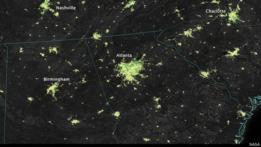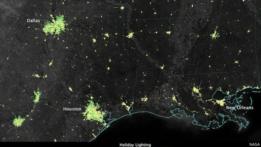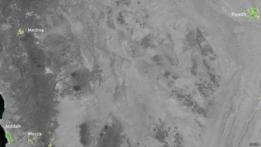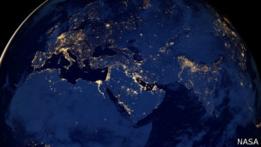Scientists from NASA, in collaboration with other centers, they used the satellite Suomi NPP to analyze how increased energy use at this time.
And found that most American cities shine between 20 and 50% more on Christmas Eve and the end of the year.
In addition, realized in the Middle East the behavior is similar.
Some cities in this region have a rise of 100% in lighting during . the month of Ramadan
Miguel Román, Puerto Rican researcher Space Flight Center, NASA said: “For the first time we were able to examine changes in lighting at the country, city or even neighborhood” .

US cities begin to be more enlightened on Thanksgiving.
Román presented the findings on Wednesday, during the Fall Meeting of the American Geophysical Union in San Francisco, USA.
From Thanksgiving to New Year
The satellite Suomi NPP, a joint project of the NASA and the National Oceanic and Atmospheric Administration, US also uses infrared cameras to detect the night lights of the Earth.
To perform the study, the research team used data collected between 2012 and autumn of this year.
When they analyzed the details found in US Cities begin to be more illuminated from Thanksgiving Day, the fourth Thursday of November, and is well maintained until January 1
See also:. What are the five most very energy efficient?
And also viewed that although the amount of light in urban centers tends to increase between 20 and 30% compared with the rest of the year, on the outskirts and in the suburbs of the cities use of light increases between 30 and 50%.
“The lighting increases mainly residential reasons,” says Roman.
According to the researcher, people stop working because take vacations, so the light turns from home for longer.

The amount of light from urban centers tends to increase between 20 and 30% and between 30 and 50% in the suburbs.
But scientists not only fixed on what happens at Christmas in America.
It also focused attention on the lighting changes taking place in the Middle East during Ramadan, the ninth month of the Muslim calendar, during which Muslims practice daily fast from dawn until sunset.
Increase of 100% in the Middle East
“Muslims fast from dawn to dusk and this slows their activity on the day, “said Eleanor Stokes, of Yale University in the US
And he explains.” People eat later, will work more Later, the markets stay open later. “
Unlike the US, the Middle East increased lighting concentrated in urban centers.
Some cities such as Riyadh and Jeddah, the capital and largest city of the west coast of Saudi Arabia respectively, experienced an increase in brightness between 60 and 100% during Ramadan, compared to other times of the year.
However, in some countries saw a slight decline in the use of electricity
Read:. A new eye in space
In some cities in Iraq, for example, the nightlight declined during the Muslim holy month.
“This is because vulnerable power lines” justified Stokes.

In the Middle East increased lighting concentrated in urban centers.
But also something similar happens in certain parts of Syria.
“In the capital, Damascus, lighting decreased by 50%, but is a consequence of the conflict,” noted the researcher.
However, during the party of Aid El Fitr, which marks the end of Ramadan, the lights around the Middle East peaked

Scientists believe that the study’s findings should feed into policy debates on how urban centers can be more energy efficient.
The researchers say that the track changes in brightness of cities helps to understand how cultural events can promote the use of energy.
And Román added that this should feed political debates about urban centers they can be more energy efficient.
No comments:
Post a Comment